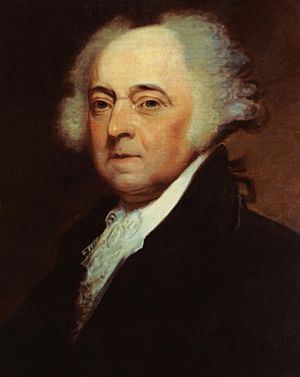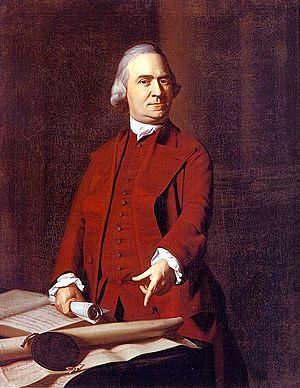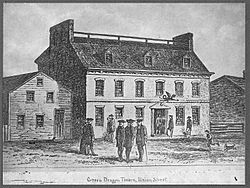Boston Caucus facts for kids
The Boston Caucus was a special group in Boston that had a big impact on politics. This was before and during the American Revolution. It was one of the first times the word caucus was used. A caucus is a meeting where people from a group or political party get together. They talk and decide on what they will do or say together.
Elisha Cooke, Jr., a well-known doctor and businessman, started the Boston Caucus around 1719. It quickly became a strong political group. Later, it became very important because of its connection to Samuel Adams. Adams was a key leader in the 1750s. He used the group in the 1760s and 1770s to help him gain political power. The Boston Caucus was known for being rebellious. They met in taverns and planned their actions. Many believed the Boston Caucus and Samuel Adams played a big part in the Boston Tea Party in 1773.
Contents
What Was the Boston Caucus?
No written records from the early years of the caucus before 1740 exist. But there is strong proof it began around 1719. Elisha Cooke, Jr. was a popular doctor and merchant who started it. He was one of the richest men in the area.
Another early member was Deacon Adams. He was the father of Samuel Adams. Deacon Adams was a wealthy businessman. He became an important person in New England politics.
Goals of the Caucus
The main goals of the caucus were to protect the interests of regular people in Boston. This included the lower and middle classes. They wanted to support programs that helped everyone.
Members of the Caucus included leaders of the "popular party." These were also known as "whigs" or "patriots." The caucus grew in influence in Boston. It helped define important issues. It also promoted political views and challenged the power of the British Crown.
The Caucus helped common people have a voice. However, it also sometimes influenced the democratic process. They would set the agenda for the Boston Town Meetings beforehand. This often meant they largely decided the results in advance.
How Did the Caucus Meetings Work?

The Rev. William Gordon wrote about the caucus in 1784. He said that over 50 years before, Samuel Adams' father and about 20 others would meet. They would make a caucus. They planned who to put into positions of power.
After they decided, they would separate. Each person would use their influence in their own area. They would get ballots with the chosen names. Then they would hand them out on election days. By working together, they usually won the elections. This is how Samuel Adams first became a representative for Boston.
John Adams, who later became President, described the caucus meetings in 1763. He said that at the meetings, officials like selectmen and representatives were chosen. This happened before they were officially chosen by the town. He also mentioned they would "smoke tobacco till you cannot see."
Adams said that after making decisions, they would send groups to meet with the "merchants' club." This suggests that important businessmen still made the final decisions. But they listened to the Caucus's views. They also considered the popular support the Caucus could gather.
This way of making decisions in private before public voting became common in U.S. politics. The Caucus set a model for how political groups could work. An inner group would choose candidates. Then they would try to ensure their election.
Samuel Adams and the Caucus

Samuel Adams' father was one of the founders of the caucus. Samuel Adams himself became an important leader of the group in the 1750s.
Adams also joined the Sons of Liberty. This was a large movement of mostly working-class men. They could be used in street protests. These protests supported the goals of the Boston leaders. The Sons of Liberty were against British rule.
The caucus always aimed to support the rights of common people. They believed in political and economic freedom for everyone. However, some people in 1763 had a less positive view. They called the caucus "the Junto." They said members were only involved for personal gain. They claimed members opposed the government for selfish reasons.
Some even said Samuel Adams used the Caucus to make himself "Dictator" of Boston. This idea came from loyalists who disliked Adams. They could not believe that common people could act in their own interest. They thought Adams must be controlling them.
Expanding Influence
From 1751, the caucus worked with a "Merchant's Club." This was a group of shipowners and wholesalers. They protested against unfair actions by royal customs officials.
Three more Caucus Clubs were formed in the 1760s. These were for the South End, North End, and Middle parts of Boston. Samuel Adams was a member of all of them. These clubs worked alongside other patriot groups. These included the Loyal Nine and the Sons of Liberty. Other clubs, like the Freemasons' lodge of St. Andrews, also had political goals.
The North End caucus likely started in 1767. Its first records are from 1772. This caucus first met in the Salutation Tavern. Later, they met in the Green Dragon Tavern. Paul Revere was a member of this group. It is at the Green Dragon Tavern that Adams and the Caucus were said to have planned the Boston Tea Party in 1773.
Notable Members
- Benjamin Kent, Attorney General of Massachusetts, Boston
Images for kids
-
John Adams, second cousin of Samuel Adams and later President of the U.S., described the caucus meetings in 1763
-
Samuel Adams, a leading member of the caucus from the 1750s




